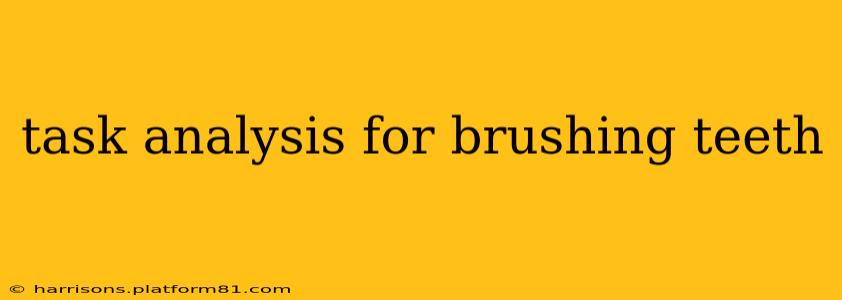Brushing your teeth seems simple, but a detailed task analysis reveals a surprisingly complex process involving several sub-tasks, cognitive processes, and potential points of failure. This analysis will break down the task into its component parts, highlighting considerations for different populations and potential areas for improvement in oral hygiene.
What are the Steps Involved in Brushing Teeth?
The seemingly straightforward task of brushing teeth can be broken down into several key stages:
-
Preparation: This involves gathering the necessary materials (toothbrush, toothpaste, water, possibly mouthwash), finding a suitable location (bathroom sink), and preparing the environment (turning on the faucet).
-
Wetting the Brush: Running the toothbrush under water to moisten the bristles. This ensures proper application of toothpaste and easier cleaning.
-
Applying Toothpaste: Dispensing the correct amount of toothpaste onto the toothbrush. This often involves considering factors like age (children typically need less), fluoride content, and personal preference (gel vs. paste).
-
Brushing: This is the core task and encompasses several sub-tasks:
- Positioning: Properly positioning the toothbrush at a 45-degree angle to the gum line.
- Technique: Using gentle, short back-and-forth strokes, ensuring all surfaces of each tooth are cleaned (outer, inner, and chewing surfaces). This includes the tongue.
- Duration: Brushing for a sufficient amount of time (typically 2 minutes). Timers or brushing apps can be helpful here.
- Pressure: Applying the correct amount of pressure; too much can damage gums and enamel.
-
Rinsing: Thoroughly rinsing the mouth with water to remove toothpaste and debris.
-
Post-Brushing: This involves rinsing the toothbrush, storing it properly (preferably upright to allow air drying), and potentially using mouthwash.
Frequently Asked Questions (FAQs)
Addressing common questions about brushing techniques and efficacy further clarifies the task analysis:
How Often Should I Brush My Teeth?
The American Dental Association recommends brushing your teeth twice a day, for at least two minutes each time, using fluoride toothpaste. Consistency is key.
What is the Best Technique for Brushing My Teeth?
The best technique involves using short, gentle back-and-forth strokes at a 45-degree angle to the gum line. Ensure you clean all surfaces of each tooth, including the chewing surfaces and tongue. Avoid scrubbing too hard, as this can damage enamel and gums. Consider using an electric toothbrush with a timer for assistance.
What Kind of Toothbrush Should I Use?
Choose a toothbrush with soft bristles. The size and shape of the brush head should comfortably fit your mouth, allowing you to easily reach all areas. Electric toothbrushes can be helpful, particularly for individuals with limited dexterity.
How Much Toothpaste Should I Use?
For adults and children over six years of age, a pea-sized amount of fluoride toothpaste is usually sufficient. For children under six, consult your dentist or pediatrician for the recommended amount, as using too much fluoride can be harmful.
What If I Miss a Spot While Brushing?
Even with careful brushing, it's possible to miss a spot. Regular dental checkups and professional cleanings are crucial for maintaining optimal oral hygiene, even with diligent home brushing.
Task Analysis for Different Populations
The task analysis for brushing teeth may need modifications for different populations:
- Children: Requires assistance and simplified instructions, focusing on fun and engaging methods to encourage consistent brushing. Smaller toothbrushes and age-appropriate toothpaste are necessary.
- Elderly: May experience decreased dexterity or cognitive impairment, requiring adapted tools and techniques, potentially including electric toothbrushes with larger handles and timers.
- Individuals with Disabilities: May require specialized tools and assistance, depending on the specific disability. This could include ergonomic toothbrushes, adaptive devices, or assistance from a caregiver.
Conclusion
A thorough task analysis reveals that effective toothbrushing is far more nuanced than it initially appears. By understanding the steps involved and adapting the process to individual needs, we can optimize oral hygiene practices and promote long-term oral health. Remember that regular dental checkups are an essential complement to consistent home brushing for maintaining optimal oral health.
